Acorn Electron - the unfortunate heir to the BBC Micro
In continuation of the history of BBC Micro, I present to your attention a review of his successor, the Acorn Electron computer.
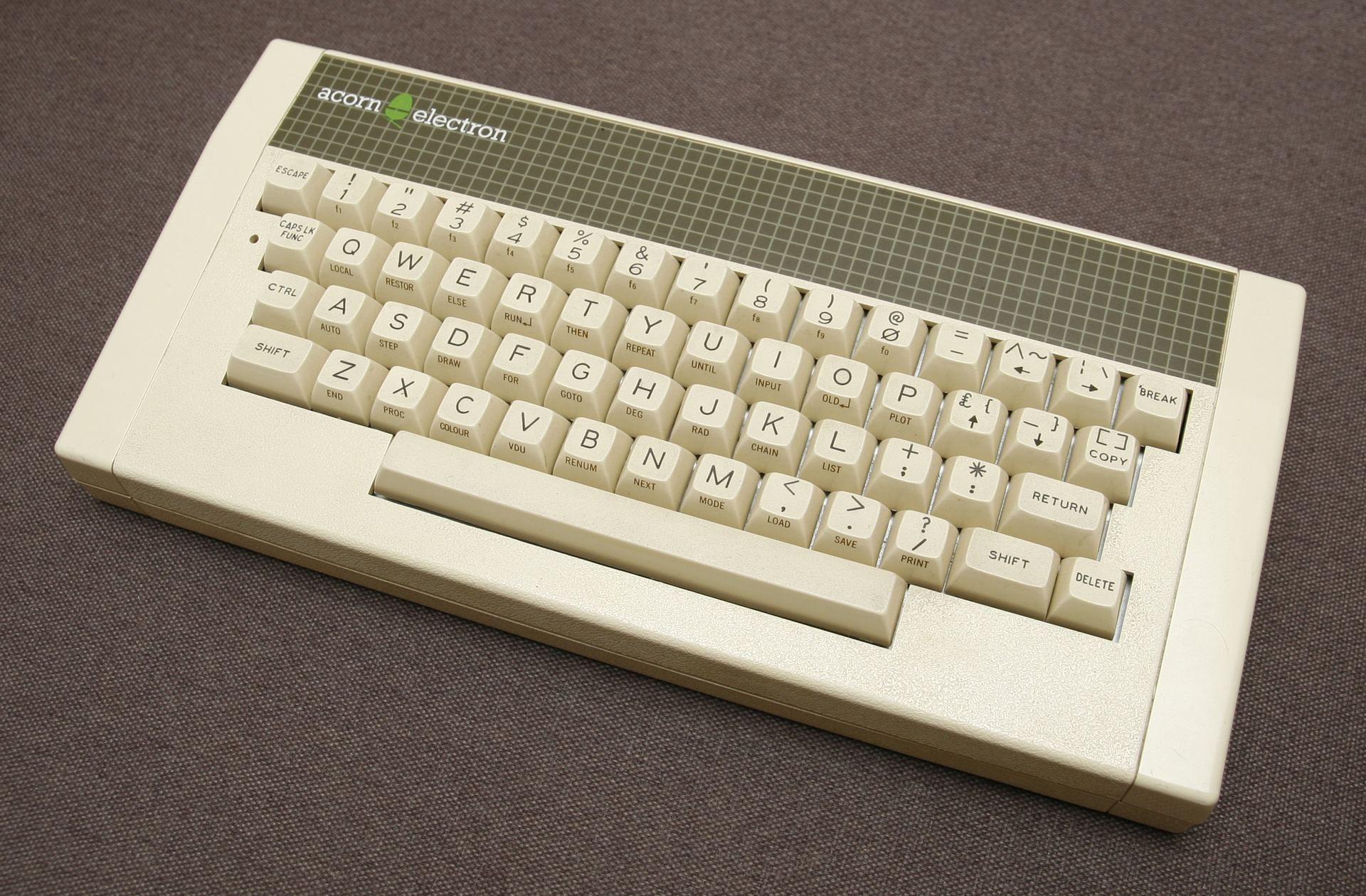
On Friday, April 23, 1982, at the Computer Fair, Clive Sinclair presented his new computer, the ZX Spectrum, which was supposed to be sold from the beginning of May. The presentation had such an effect that Commodore reduced the price of its VIC-20 (by the way, the first computer of Linus Torvalds) to 100 pounds, and Acorn co-founder Herman Hauser in an interview with the Popular Computing Weekly newspaper announced the development of a competing machine from Acorn, which should be released in end of the year.
Sinclair promised to sell the ZX Spectrum with 48 Kb of memory for 175 pounds, the new Acorn car, which “most likely will be called Electron”, should be available at a price from 120 to 150 pounds - it was written in the newspaper. The new computer promises higher resolution color graphics than the ZX Spectrum and backward compatibility with BBC Micro. With this statement, Acorn tried to refute Sinclair’s statement that ZX Spectrum would undermine BBC Micro sales and push it out of the home computer market.
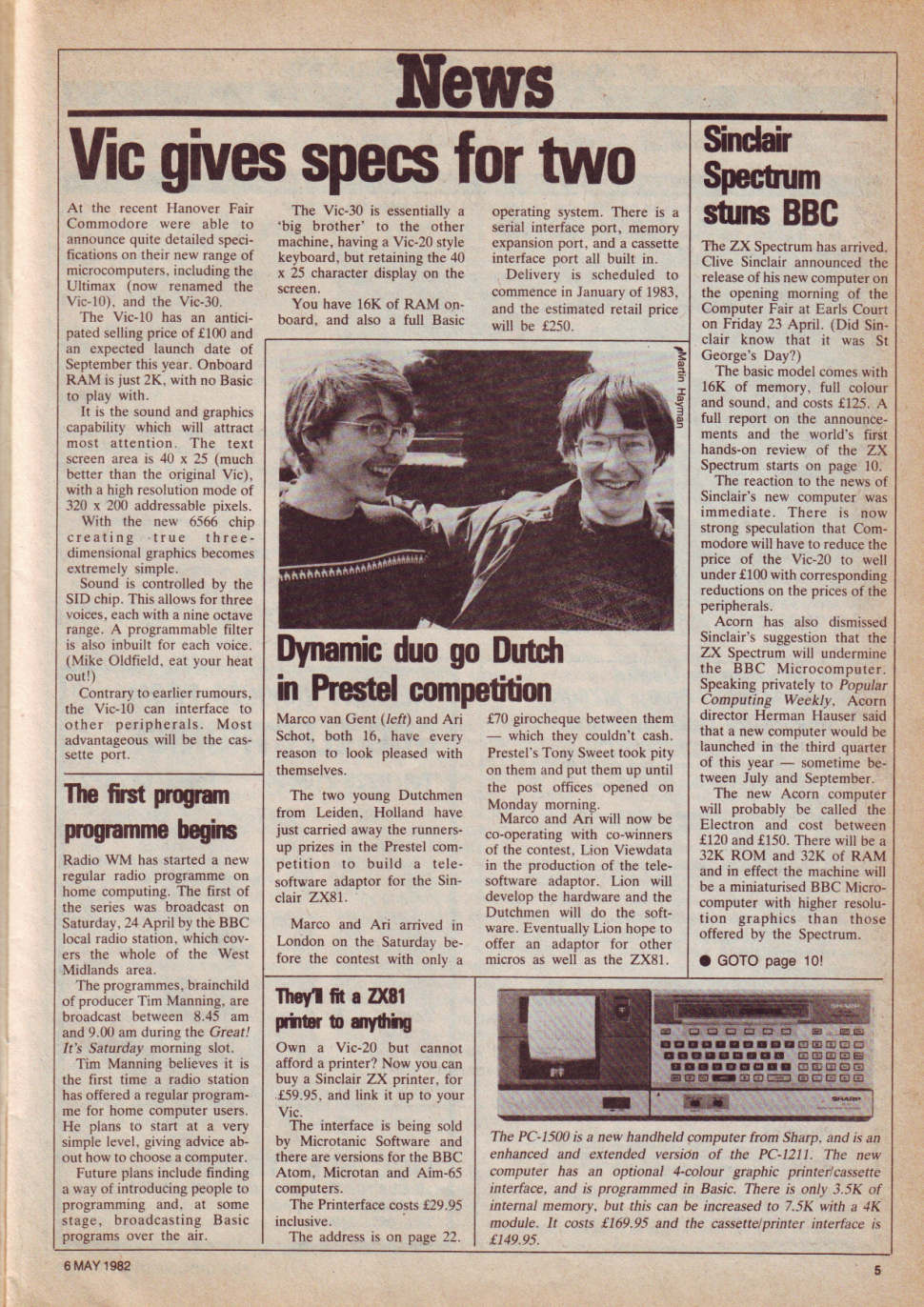
Thanks to a computer literacy project, BBC Micro was in almost all schools, but this computer was not positioned as a home computer. Chris Curry said: “The number of cars that users buy for home use surprised us. We did not plan to compete with the ZX Spectrum in this market, but people who want something better than Spectrum are returning to the BBC. ” For Acorn, it was obvious that a car was needed that would be cheaper than the BBC Micro (it cost 399 pounds) and could compete with Sinclair, Commodore VIC-20 and Dragon 32 computers.
Not all Acorn employees supported the development of a simplified BBC Micro, but Chris Curry and Herman Hauser convinced them that they needed to develop a computer for the home market.
The key to reducing the cost of a computer should be to reduce the number of chips. Instead of a discrete set of logic elements on which the BBC Micro was built, a matrix crystal , ULA, should be installed in Electron. Clive Sinclair applied this approach in the production of ZX81 and Spectrum. “This allowed us to take a computer with 102 chips on the motherboard and reduce their number to 12-14 pieces, which significantly reduces the complexity and cost of the motherboard,” said Steve Furber from Acorn's R & D division. Another step towards cost reduction was memory. At the time of development of the BBC Micro, only 16-kilobit DRAM memory was available, Electron planned to install 64-kilobit chips that appeared on the market. Thus, to provide 32 KB of memory, only 4 chips were sufficient; however, this required double access to each byte of memory. It was a trade-off between cost and memory speed.
The first photo of the new Acorn Electron appeared in the December magazine Your Computer. The case and the motherboard were already ready, even “Copyright 1982” was on the first boards, but there were still problems with the ULA, mass production was not ready.
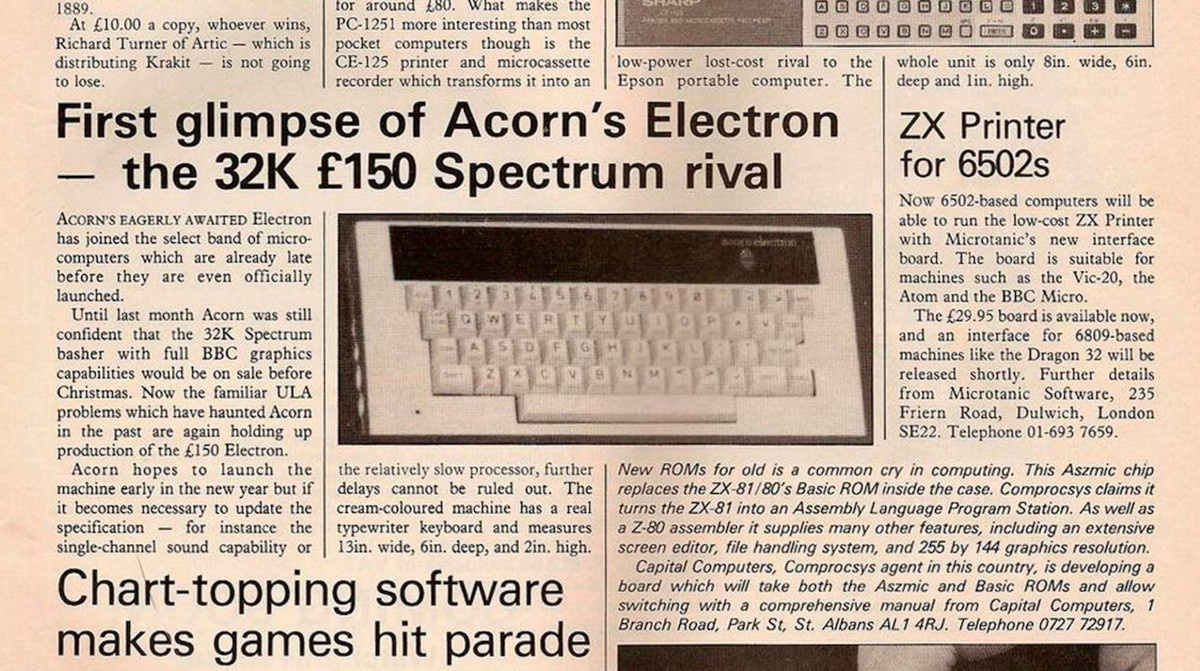
During the development of BBC Micro, Acorn engineers had problems with video chip overheating in high resolution mode and Steve Furber carefully worked through this part to fit the technological capabilities of Ferranti, the company that makes the ULA.
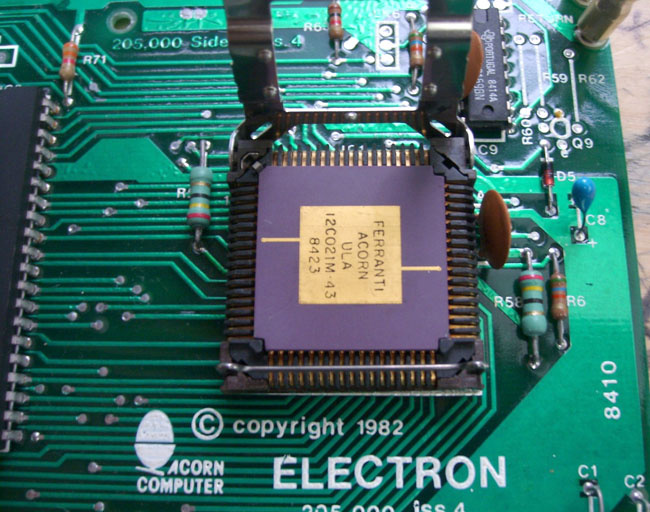
Source: theregister.co.uk
Interestingly, the same company did the ULA for the ZX Spectrum.

ULA from Ferranti on the ZX Spectrum board
Furber's fears were confirmed, in the ULA trial batch there was a problem with the 640x256 high resolution video mode. Ferranti engineers were convinced that this was a design error, Acorn believed that the problem was in the production of the chips themselves. As a result of lengthy joint tests, engineers were able to solve this problem and establish the release of ULA.
In January 1983, Chris Curry promised to release Electron by the end of March. This promise pursued the company for another half a year.

Publication in Popular Computing Weekly of June 8, 1983.
Acorn Electron was presented at the Acorn User Exhibition on August 25, 1983. The finished computer was exactly the same as in the photo in last year's journal Your Computer. Inside was a 6502A processor, running at 2 MHz, which was connected to four 64-bit RAM chips, two 16-kilobyte ROMs and a ULA monumental to Steve Furber. At the presentation, Houser boasted: “ULA is by far the largest custom chip (I didn’t figure out how to translate this term so it doesn’t lose meaning), which was installed in a computer. It contains over 2,400 transistors. ” ULA was the largest chip on the motherboard, even more than the 6502 processor.
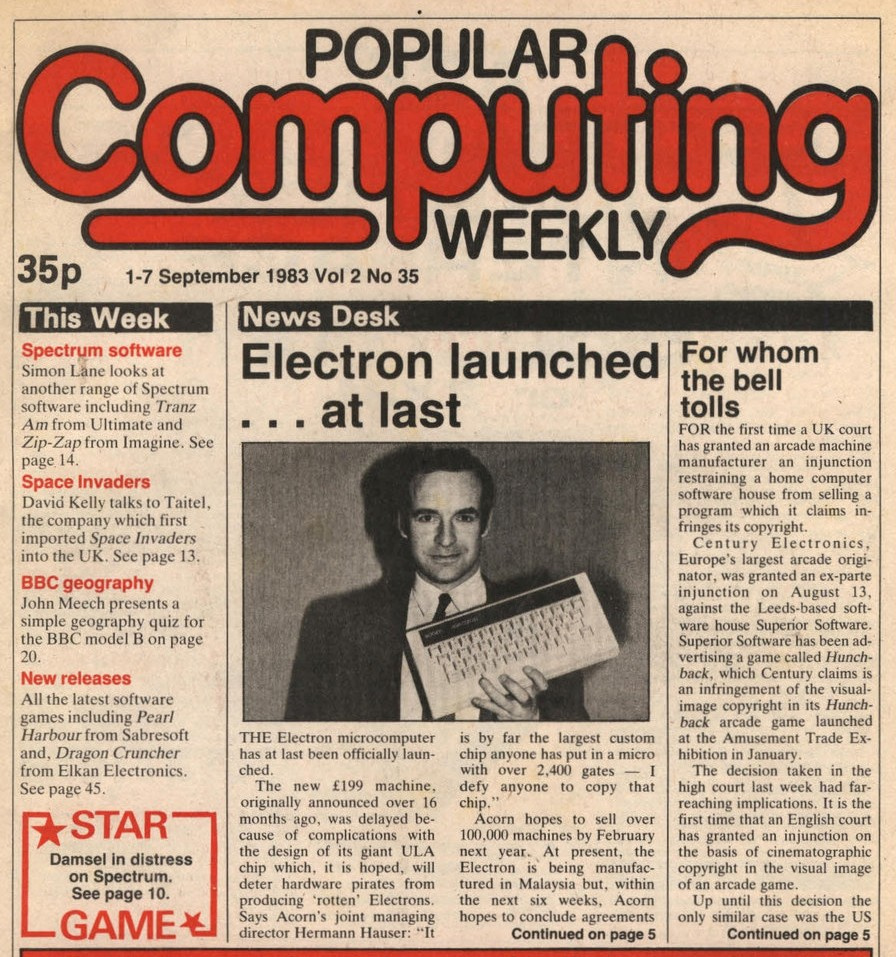
The 6th version of the board is already installed in my copy
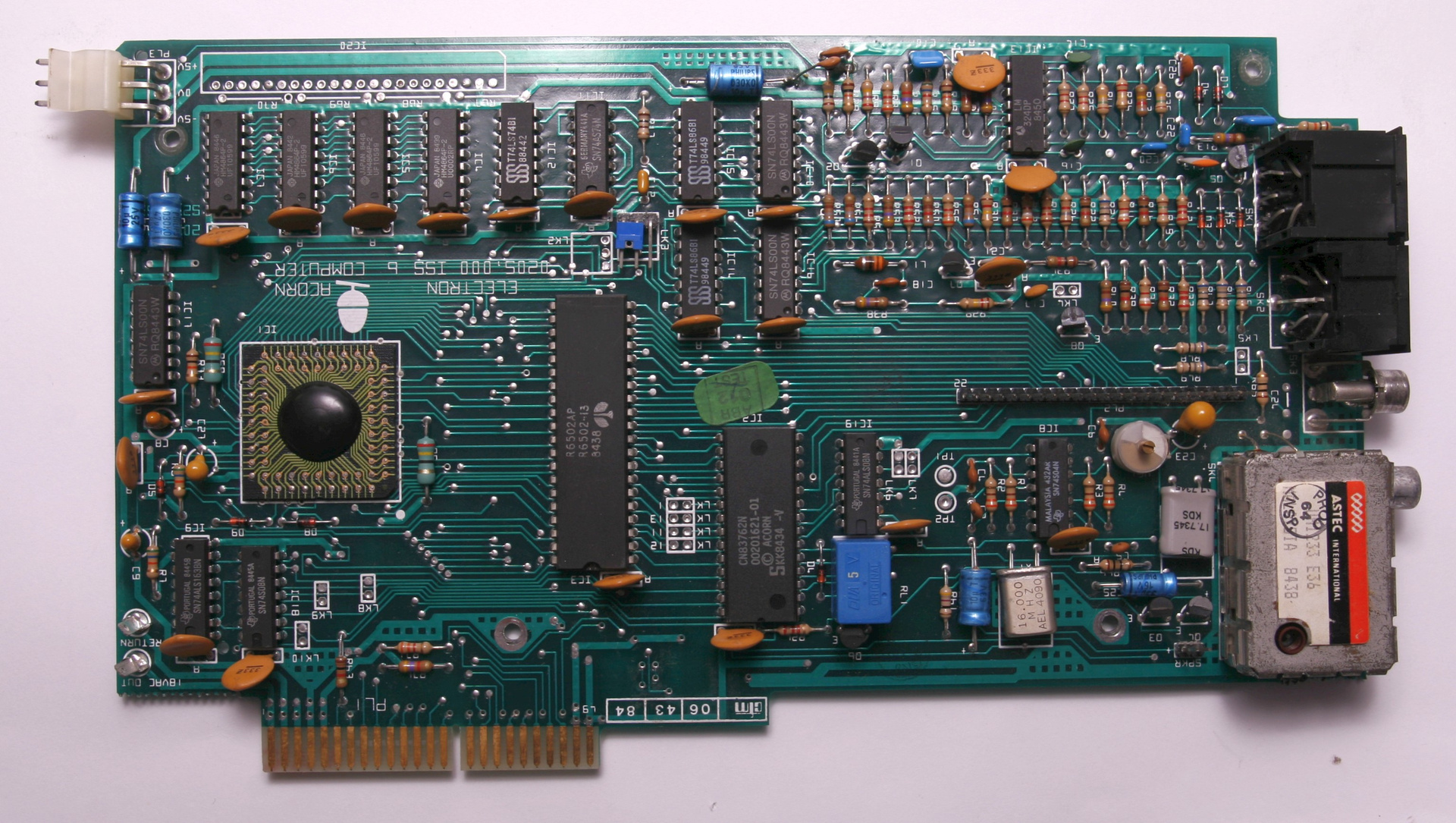
By comparison, the BBC Micro motherboard
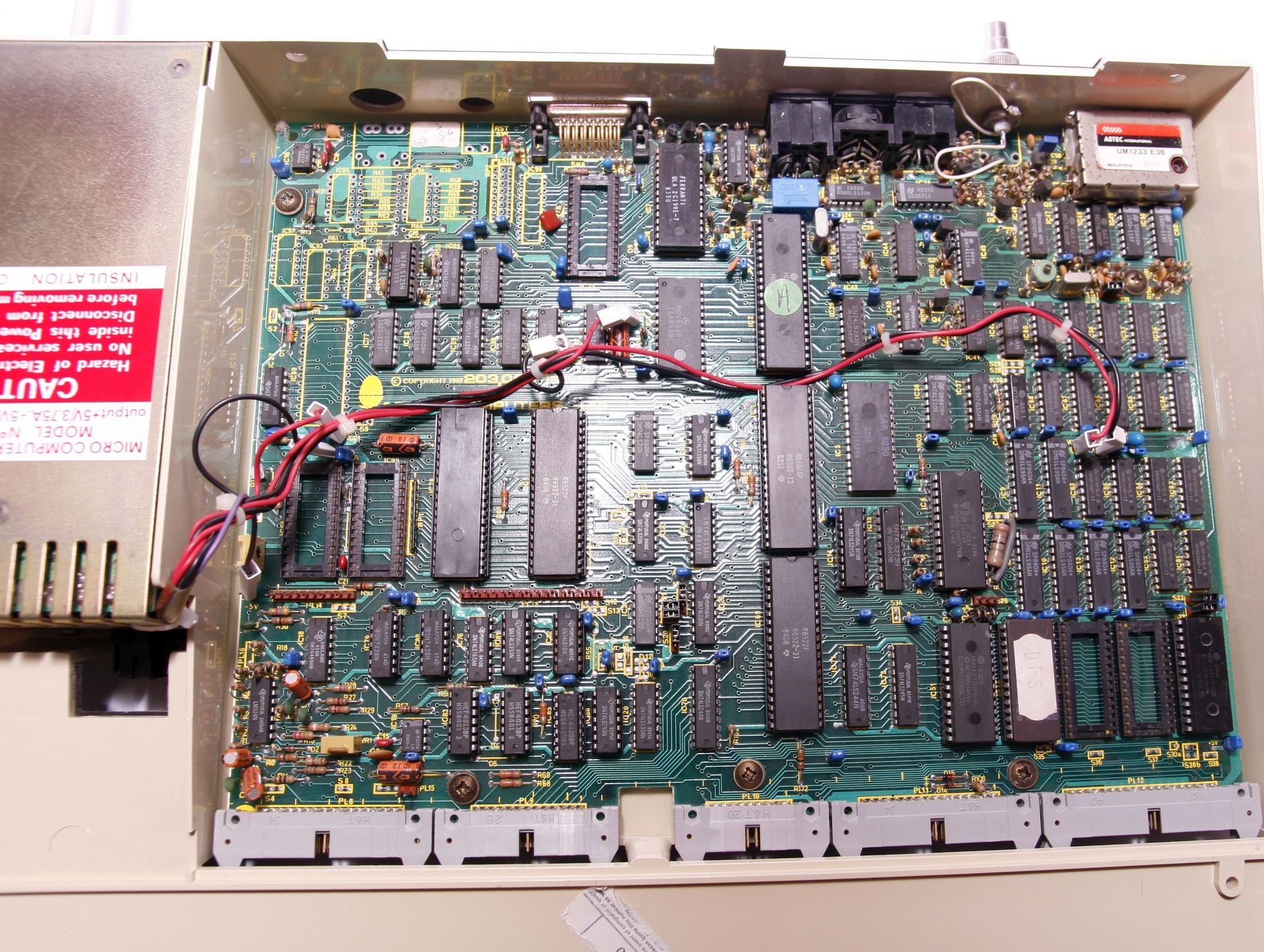
Another goal that Acorn pursued when choosing a ULA was the fight against piracy. In the early 80s, many Apple II clones appeared, almost all of them were from the Far East. This computer was easy to clone using standard components and a clear layout of the motherboard. British computers have always been difficult to copy due to the presence of the ULA chip. In 1982, Chris Curry said: "Sinclair may not worry about his ZX81, this is the perfect computer for cloning in Taiwan, but it contains the ULA."
ZX Spectrum, however, has been cloned, including ours. The first clone is considered to be the development of engineers from the Lviv Polytechnic University unit, who did ULA reverse engineering and recreated the chip on discrete elements in 1985, but Acorn Electron was never cloned.
Acorn Electron versus BBC Micro
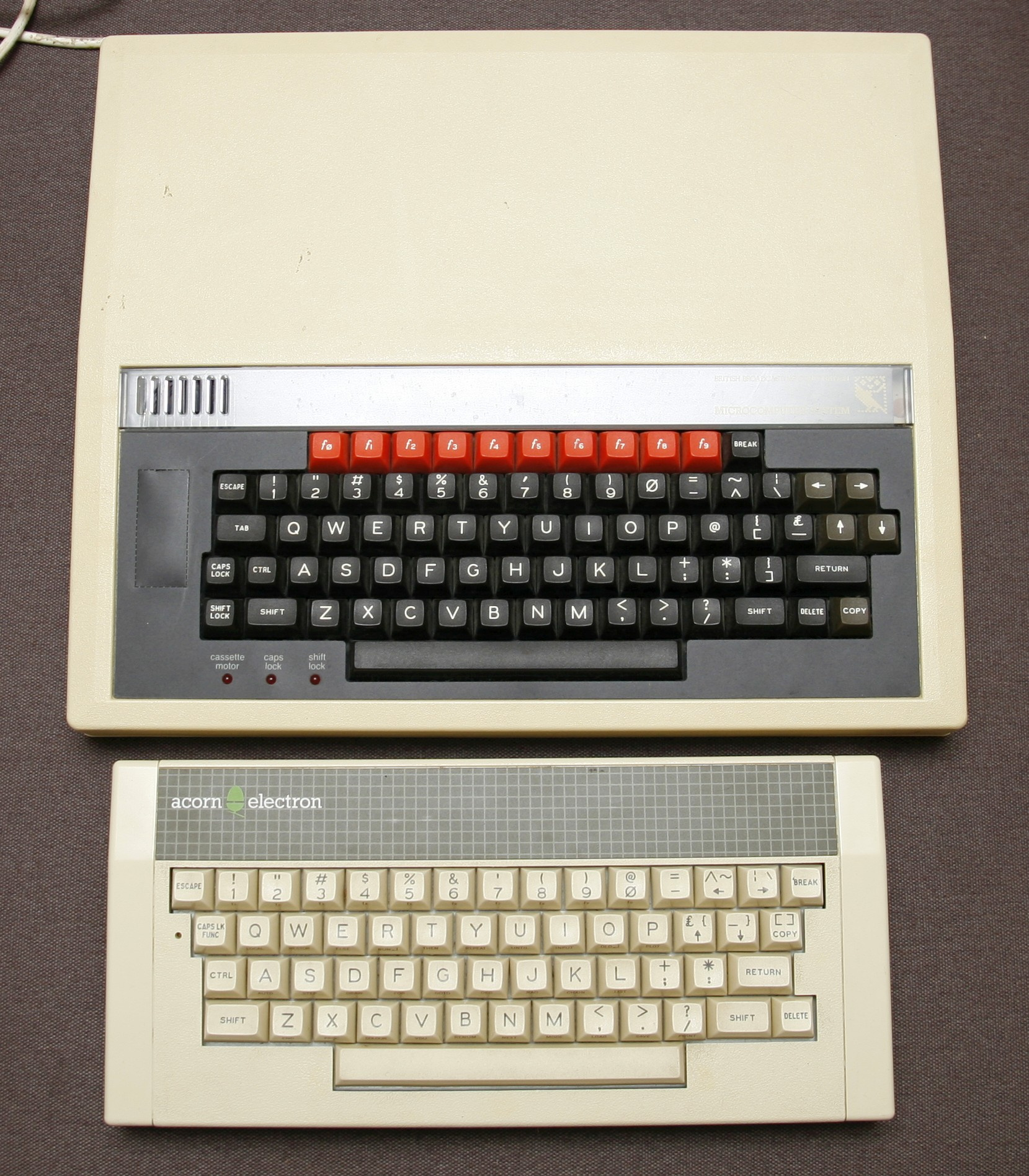
Appearance of packaging with Electron
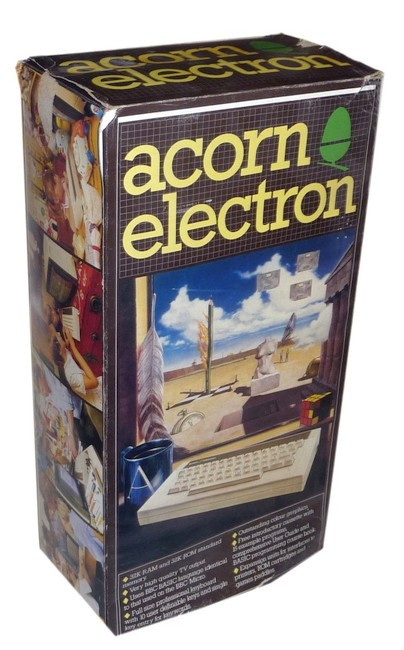
The electron was supplied with a compact external power supply, instructions and a starting cassette with programs.
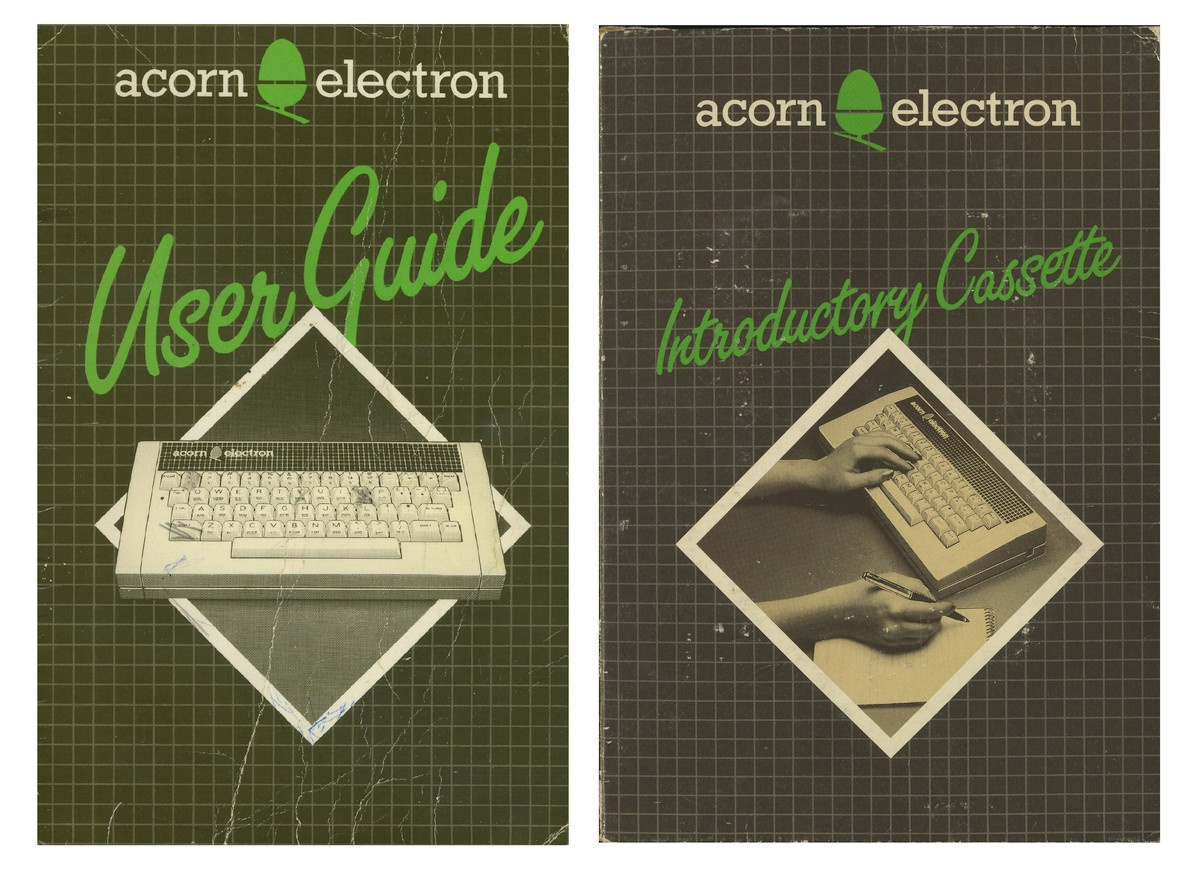
The programs and games cassettes had their own corporate identity, even though they could be launched on BBC Micro. For example, there was a program for those who watch their weight and the clone Pacman - Snapper.
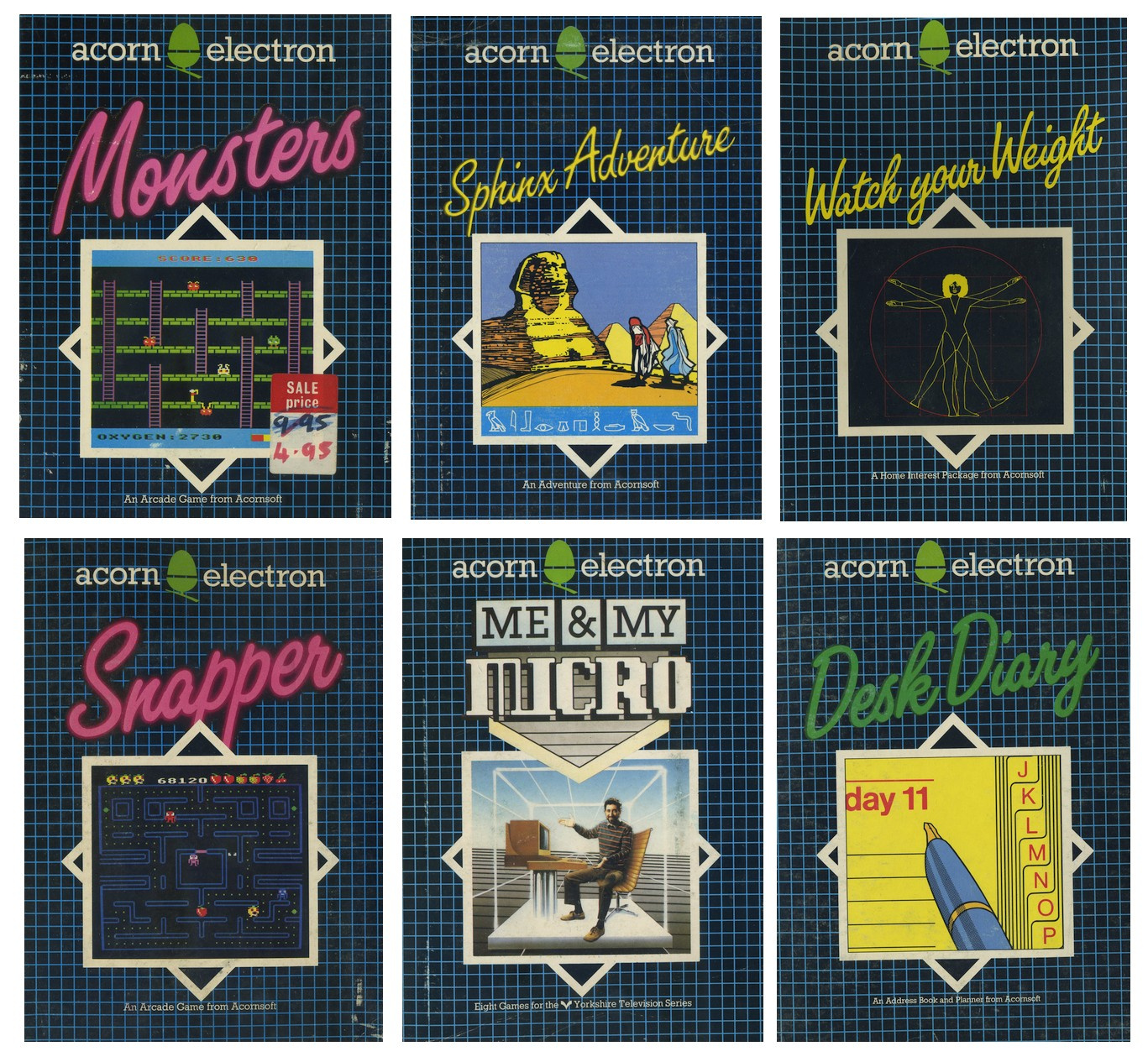
Source: instagram.com/itmuseum
On many third-party cassettes, it was stated that the programs will work on both Electron and BBC Micro
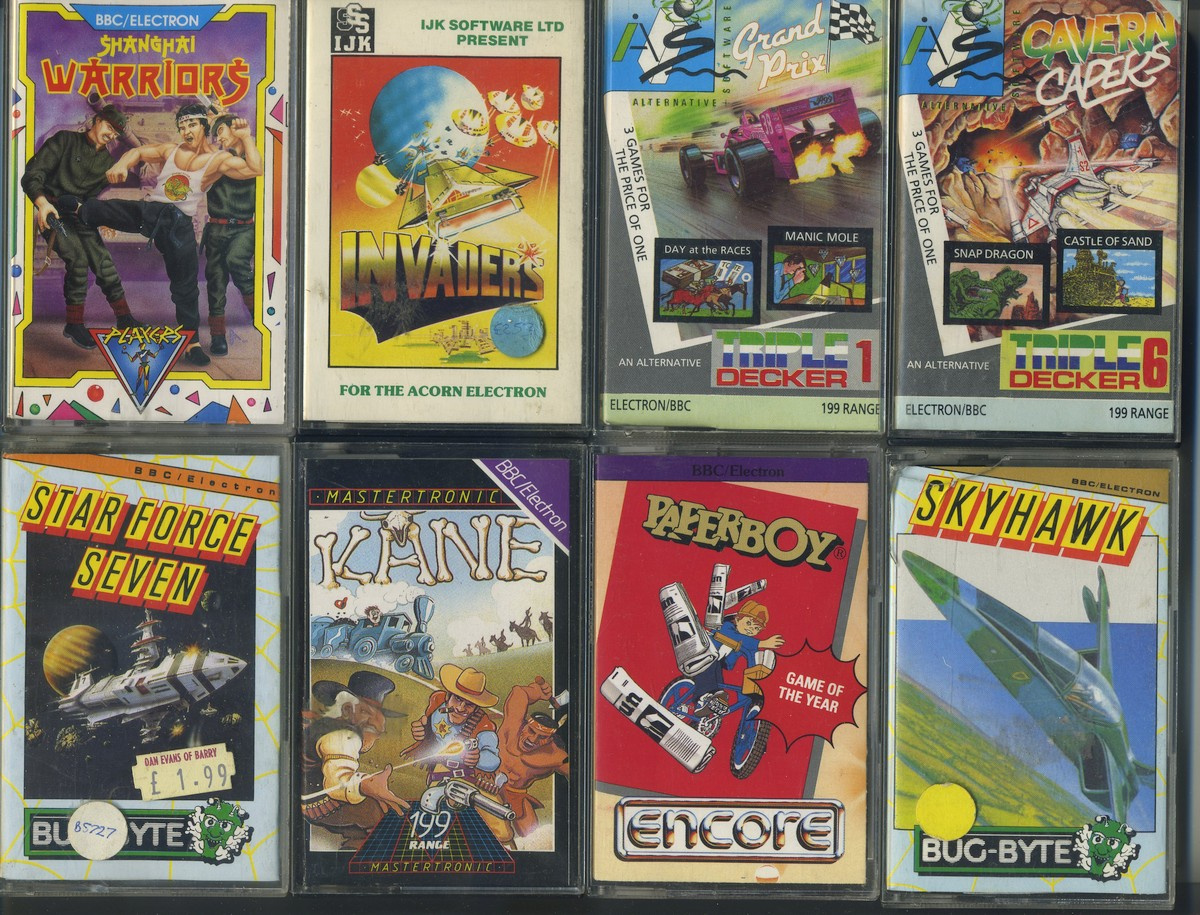
For the computer was released several expansion modules. Acorn Plus 1 module added analog interface, printer port and two ROM slots
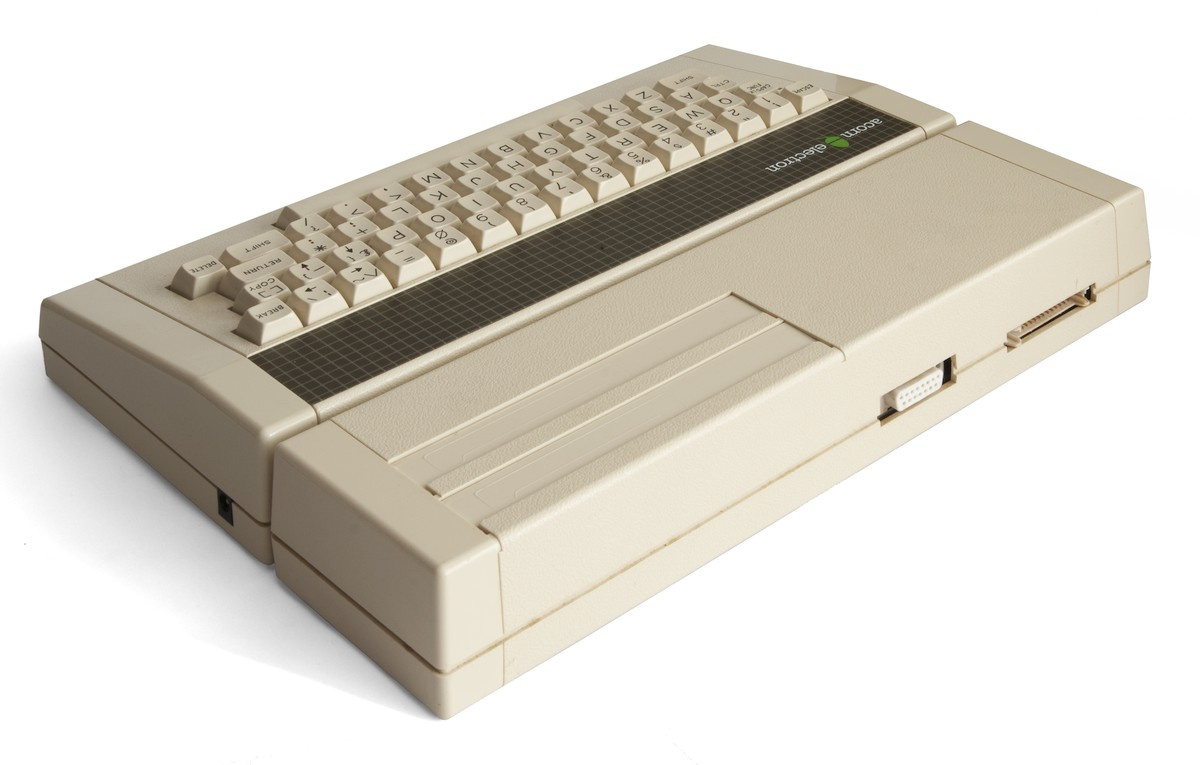
Source: en.wikipedia.org
Acorn Plus 2 was supposed to provide connectivity to Econet, but it was never released to the market.
Acorn Plus 3 added a 3-inch drive to the computer:
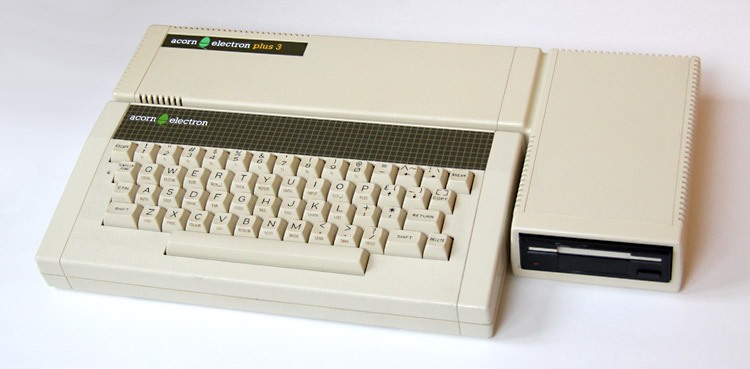
The first critical review was published in Popular Computing Weekly less than a week after the official presentation of the computer. Keith and Stephen Bryan, comparing Electron to BBC Micro, note that due to the memory organization, Electron is twice as slow as its predecessor in RAM operations. Moving the video driver to the ULA also had an impact on speed. Games that were released for the BBC could work on Electron, but much slower. Further in article the British metaphor untranslatable for me follows :)
In the October issue of Practical Computing, Neville Mod, with British humor, also criticized Electron for speed: "The main program usually loads, but then works like an arthritic snail, about 2.0-4.3 times slower than it should."
Another problem was the production of Electrons. Acorn has a contract in Malaysia, as well as several local businesses. The stores through which Electron was sold had a pre-order for several months ahead. By February 1984 Acorn planned to sell 100 thousand cars. However, in the 84th, the demand for home computers fell sharply, the market became saturated, the company began to incur losses. Electron was a fairly expensive home computer in 1982 and was reluctant to buy it in 1984. In an attempt to increase sales, the company reduced the cost to £ 129, which further aggravated the situation. As a result, Acorn had to agree to a deal with the Italian Olivetti, the result of which was the sale of 49.3% of the company's shares, but this decision saved Acorn and she presented the ARM architecture to the world.
PS:
When I started this article, Tony Smith ’s article " Acorn's would-be ZX Spectrum killer, the Electron, is 30 " was taken as a basis, in which he talks about Herman Hauser’s interview for Popular Computing Weekly in June of 82 - almost 2 months later after the announcement of the ZX Spectrum. I managed to find a scan of this newspaper, it came out on May 6, less than 2 weeks after Clive Sinclair presented the new model, which significantly changes the perception of the situation. At the same time, small changes were made to the wiki , which indicated that the first edition of the newspaper was released in October 1982. Digital archeology is still a fascinating thing. Thank you for attention.
PPS:
In the film Micro Men , which I highly recommend to see, there are shots where Chris Curry walks through a warehouse littered with Electrons. In general, the computer is really not rare, on the British ebay is full of offers from 50 pounds.

On Friday, April 23, 1982, at the Computer Fair, Clive Sinclair presented his new computer, the ZX Spectrum, which was supposed to be sold from the beginning of May. The presentation had such an effect that Commodore reduced the price of its VIC-20 (by the way, the first computer of Linus Torvalds) to 100 pounds, and Acorn co-founder Herman Hauser in an interview with the Popular Computing Weekly newspaper announced the development of a competing machine from Acorn, which should be released in end of the year.
Sinclair promised to sell the ZX Spectrum with 48 Kb of memory for 175 pounds, the new Acorn car, which “most likely will be called Electron”, should be available at a price from 120 to 150 pounds - it was written in the newspaper. The new computer promises higher resolution color graphics than the ZX Spectrum and backward compatibility with BBC Micro. With this statement, Acorn tried to refute Sinclair’s statement that ZX Spectrum would undermine BBC Micro sales and push it out of the home computer market.

Thanks to a computer literacy project, BBC Micro was in almost all schools, but this computer was not positioned as a home computer. Chris Curry said: “The number of cars that users buy for home use surprised us. We did not plan to compete with the ZX Spectrum in this market, but people who want something better than Spectrum are returning to the BBC. ” For Acorn, it was obvious that a car was needed that would be cheaper than the BBC Micro (it cost 399 pounds) and could compete with Sinclair, Commodore VIC-20 and Dragon 32 computers.
Not all Acorn employees supported the development of a simplified BBC Micro, but Chris Curry and Herman Hauser convinced them that they needed to develop a computer for the home market.
The key to reducing the cost of a computer should be to reduce the number of chips. Instead of a discrete set of logic elements on which the BBC Micro was built, a matrix crystal , ULA, should be installed in Electron. Clive Sinclair applied this approach in the production of ZX81 and Spectrum. “This allowed us to take a computer with 102 chips on the motherboard and reduce their number to 12-14 pieces, which significantly reduces the complexity and cost of the motherboard,” said Steve Furber from Acorn's R & D division. Another step towards cost reduction was memory. At the time of development of the BBC Micro, only 16-kilobit DRAM memory was available, Electron planned to install 64-kilobit chips that appeared on the market. Thus, to provide 32 KB of memory, only 4 chips were sufficient; however, this required double access to each byte of memory. It was a trade-off between cost and memory speed.
The first photo of the new Acorn Electron appeared in the December magazine Your Computer. The case and the motherboard were already ready, even “Copyright 1982” was on the first boards, but there were still problems with the ULA, mass production was not ready.

During the development of BBC Micro, Acorn engineers had problems with video chip overheating in high resolution mode and Steve Furber carefully worked through this part to fit the technological capabilities of Ferranti, the company that makes the ULA.

Source: theregister.co.uk
Interestingly, the same company did the ULA for the ZX Spectrum.

ULA from Ferranti on the ZX Spectrum board
Furber's fears were confirmed, in the ULA trial batch there was a problem with the 640x256 high resolution video mode. Ferranti engineers were convinced that this was a design error, Acorn believed that the problem was in the production of the chips themselves. As a result of lengthy joint tests, engineers were able to solve this problem and establish the release of ULA.
In January 1983, Chris Curry promised to release Electron by the end of March. This promise pursued the company for another half a year.

Publication in Popular Computing Weekly of June 8, 1983.
Acorn Electron was presented at the Acorn User Exhibition on August 25, 1983. The finished computer was exactly the same as in the photo in last year's journal Your Computer. Inside was a 6502A processor, running at 2 MHz, which was connected to four 64-bit RAM chips, two 16-kilobyte ROMs and a ULA monumental to Steve Furber. At the presentation, Houser boasted: “ULA is by far the largest custom chip (I didn’t figure out how to translate this term so it doesn’t lose meaning), which was installed in a computer. It contains over 2,400 transistors. ” ULA was the largest chip on the motherboard, even more than the 6502 processor.

The 6th version of the board is already installed in my copy

By comparison, the BBC Micro motherboard

Another goal that Acorn pursued when choosing a ULA was the fight against piracy. In the early 80s, many Apple II clones appeared, almost all of them were from the Far East. This computer was easy to clone using standard components and a clear layout of the motherboard. British computers have always been difficult to copy due to the presence of the ULA chip. In 1982, Chris Curry said: "Sinclair may not worry about his ZX81, this is the perfect computer for cloning in Taiwan, but it contains the ULA."
ZX Spectrum, however, has been cloned, including ours. The first clone is considered to be the development of engineers from the Lviv Polytechnic University unit, who did ULA reverse engineering and recreated the chip on discrete elements in 1985, but Acorn Electron was never cloned.
Acorn Electron versus BBC Micro

Appearance of packaging with Electron

The electron was supplied with a compact external power supply, instructions and a starting cassette with programs.

The programs and games cassettes had their own corporate identity, even though they could be launched on BBC Micro. For example, there was a program for those who watch their weight and the clone Pacman - Snapper.

Source: instagram.com/itmuseum
On many third-party cassettes, it was stated that the programs will work on both Electron and BBC Micro

For the computer was released several expansion modules. Acorn Plus 1 module added analog interface, printer port and two ROM slots

Source: en.wikipedia.org
Acorn Plus 2 was supposed to provide connectivity to Econet, but it was never released to the market.
Acorn Plus 3 added a 3-inch drive to the computer:

The first critical review was published in Popular Computing Weekly less than a week after the official presentation of the computer. Keith and Stephen Bryan, comparing Electron to BBC Micro, note that due to the memory organization, Electron is twice as slow as its predecessor in RAM operations. Moving the video driver to the ULA also had an impact on speed. Games that were released for the BBC could work on Electron, but much slower. Further in article the British metaphor untranslatable for me follows :)
Although it is a price-sensitive micro-world, perhaps, it’s not worth it.
In the October issue of Practical Computing, Neville Mod, with British humor, also criticized Electron for speed: "The main program usually loads, but then works like an arthritic snail, about 2.0-4.3 times slower than it should."
Another problem was the production of Electrons. Acorn has a contract in Malaysia, as well as several local businesses. The stores through which Electron was sold had a pre-order for several months ahead. By February 1984 Acorn planned to sell 100 thousand cars. However, in the 84th, the demand for home computers fell sharply, the market became saturated, the company began to incur losses. Electron was a fairly expensive home computer in 1982 and was reluctant to buy it in 1984. In an attempt to increase sales, the company reduced the cost to £ 129, which further aggravated the situation. As a result, Acorn had to agree to a deal with the Italian Olivetti, the result of which was the sale of 49.3% of the company's shares, but this decision saved Acorn and she presented the ARM architecture to the world.
PS:
When I started this article, Tony Smith ’s article " Acorn's would-be ZX Spectrum killer, the Electron, is 30 " was taken as a basis, in which he talks about Herman Hauser’s interview for Popular Computing Weekly in June of 82 - almost 2 months later after the announcement of the ZX Spectrum. I managed to find a scan of this newspaper, it came out on May 6, less than 2 weeks after Clive Sinclair presented the new model, which significantly changes the perception of the situation. At the same time, small changes were made to the wiki , which indicated that the first edition of the newspaper was released in October 1982. Digital archeology is still a fascinating thing. Thank you for attention.
PPS:
In the film Micro Men , which I highly recommend to see, there are shots where Chris Curry walks through a warehouse littered with Electrons. In general, the computer is really not rare, on the British ebay is full of offers from 50 pounds.
All Articles